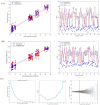Rapid quantitative typing spectra model for distinguishing sweet and bitter apricot kernels
- PMID: 35919360
- PMCID: PMC9339053
- DOI: 10.1007/s10068-022-01095-y
Rapid quantitative typing spectra model for distinguishing sweet and bitter apricot kernels
Abstract
Amygdalin content in apricot kernels is an essential factor in the rapid and nondestructive identification of sweet or bitter apricot kernels through spectroscopy. Now, amygdalin content has been determined by high-performance liquid chromatography and near-infrared spectral database to construct a model so that the sweet or bitter apricot kernels could be identified and classified. Principal component analysis-K-nearest neighbor classification algorithm combined with multivariate scattering correction pretreatment method could distinguish sweet and bitter apricot kernels in the wavelength range of 1650-1740 nm with 98.3% accuracy and apricot kernel species with 96.3% recognition rate in the full wavelength spectrum. Furthermore, prediction of amygdalin content in bitter and sweet apricot kernels by partial least squares model was superior to that by back-propagation neural network model. This study provides a theoretical basis for quality identification of apricot kernel quality, as well as a method for nondestructive and rapid detection of sweet and bitter apricot kernels.
Supplementary information: The online version contains supplementary material available at 10.1007/s10068-022-01095-y.
Keywords: Amygdalin; Apricot kernel; High-performance liquid chromatography; Near-infrared spectroscopy; Quantitative detection model.
© The Korean Society of Food Science and Technology 2022.
Conflict of interest statement
Conflict of interestThe authors declare no conflict of interest.
Figures



Similar articles
-
Apricot kernel characterization, oil extraction, and its utilization: a review.Food Sci Biotechnol. 2023 Jan 7;32(3):249-263. doi: 10.1007/s10068-022-01228-3. eCollection 2023 Mar. Food Sci Biotechnol. 2023. PMID: 36778095 Free PMC article. Review.
-
Transcriptome analysis reveals genes associated with the bitter-sweet trait of apricot kernels.For Res (Fayettev). 2024 Feb 29;4:e007. doi: 10.48130/forres-0024-0004. eCollection 2024. For Res (Fayettev). 2024. PMID: 39524411 Free PMC article.
-
Accumulation Pattern of Amygdalin and Prunasin and Its Correlation with Fruit and Kernel Agronomic Characteristics during Apricot (Prunus armeniaca L.) Kernel Development.Foods. 2021 Feb 11;10(2):397. doi: 10.3390/foods10020397. Foods. 2021. PMID: 33670310 Free PMC article.
-
Phytochemical characterization and biological activity of apricot kernels' extract in yeast-cell based tests and hepatocellular and colorectal carcinoma cell lines.J Ethnopharmacol. 2021 Oct 28;279:114333. doi: 10.1016/j.jep.2021.114333. Epub 2021 Jun 17. J Ethnopharmacol. 2021. PMID: 34146630
-
Apricot Kernel: Bioactivity, Characterization, Applications, and Health Attributes.Foods. 2022 Jul 22;11(15):2184. doi: 10.3390/foods11152184. Foods. 2022. PMID: 35892769 Free PMC article. Review.
Cited by
-
Apricot kernel characterization, oil extraction, and its utilization: a review.Food Sci Biotechnol. 2023 Jan 7;32(3):249-263. doi: 10.1007/s10068-022-01228-3. eCollection 2023 Mar. Food Sci Biotechnol. 2023. PMID: 36778095 Free PMC article. Review.
References
-
- Aman S, Babita P. An efficient diagnosis system for detection of liver disease using a novel integrated method based on principal component analysis and K-nearest neighbor PCA-KNN. International Journal of Healthcare Information Systems and Informatics. 2016;11:56–69. doi: 10.4018/IJHISI.2016100103. - DOI
-
- Camps C, Christen D. Non-destructive assessment of apricot fruit quality by portable visible-near infrared spectroscopy. LWT—Food Science and Technology. 2009;42:1125–1131. doi: 10.1016/j.lwt.2009.01.015. - DOI
-
- Deng P, Cui B, Zhu HL, Phommakoun B, Zhang D, Li YM, Zhao F, Zhao Z. Accumulation pattern of amygdalin and prunasin and its correlation with fruit and kernel agronomic characteristics during apricot (Prunus armeniaca L.) kernel development. Foods (basel, Switzerland) 2021;10:397. doi: 10.3390/foods10020397. - DOI - PMC - PubMed
LinkOut - more resources
Full Text Sources
